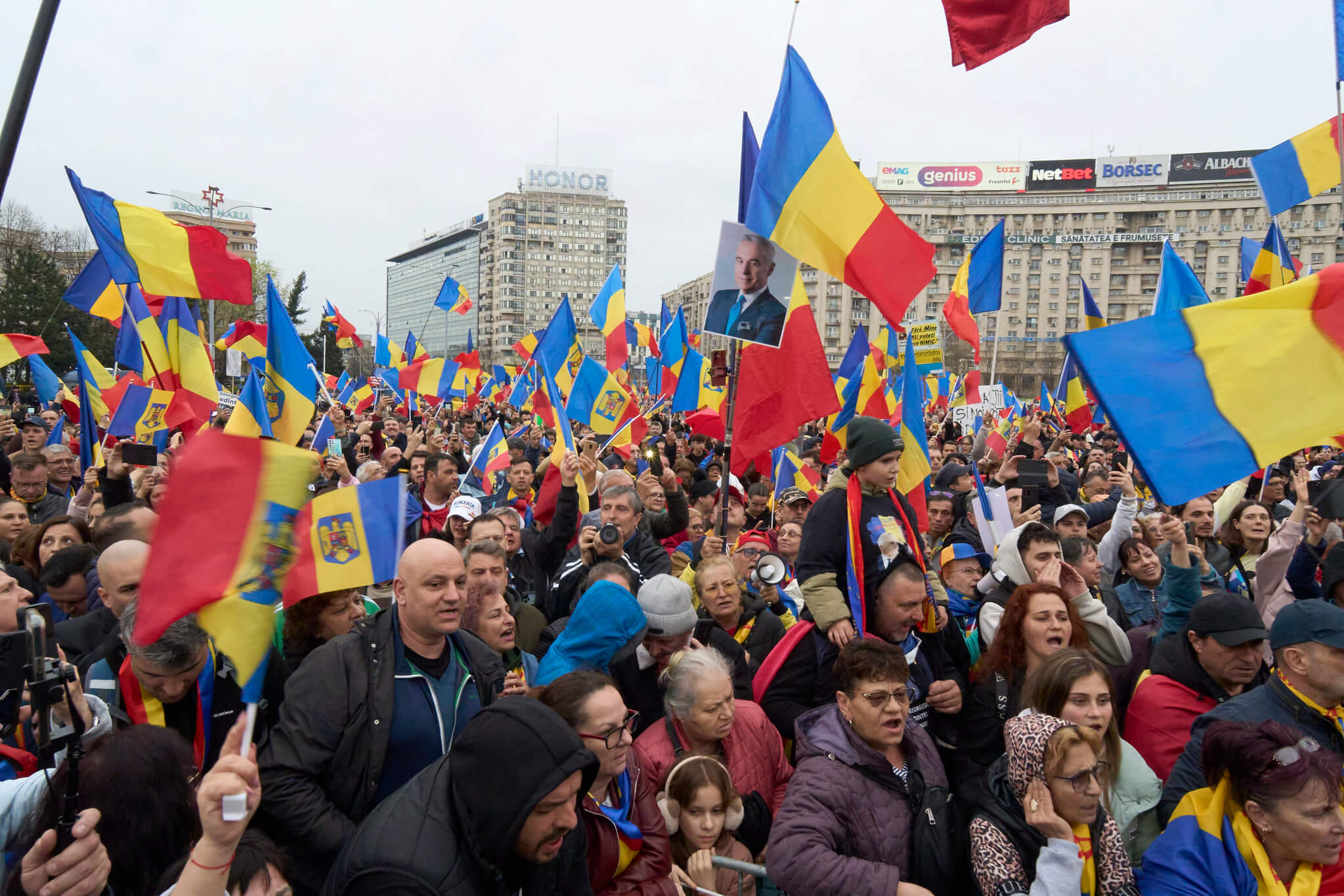Romania, Foreign Election Interference, and a Dangerous U.S. Retreat

Published by The Lawfare Institute
in Cooperation With

This weekend, Romanian citizens will elect a new president. The election in Romania, a NATO member since 2004, a staunch ally for Ukraine, and a bulwark against Russian aggression, is consequential not just for its 19 million citizens but also, arguably, for the 38 million citizens in neighboring Ukraine, as well as 449 million citizens living across the European Union.
Voters will head to the polls to choose between a right-wing nationalist who has promised to “Make Romania Great Again” and a pro-Western, centrist candidate who has said the election is a choice “between a democratic, stable and respected Romania in Europe—and a dangerous path of isolation, populism and defiance of the rule of law.”
The candidates may sound typical for today’s Europe; however, the election has been anything but, thanks in part to a controversial move by the Romanian Supreme Court to declare an initial round of voting illegitimate over concerns of Russian meddling. Though the investigation is ongoing, the saga of the annulled election offers a cautionary tale for democratic countries grappling with foreign election interference. The Romanian experience underscores the need for mechanisms that address the aftermath of foreign election interference, as well as mechanisms that bolster citizens’ individual defenses against such interference well before it happens. It also underscores the folly of the direction the U.S. is now taking with respect to this ongoing threat.
The Romanian Election and Evidence of Russian Interference
The first round of voting initially took place on Nov. 24, 2024, but no candidate received the requisite 50 percent of votes necessary to win. Per Romanian election rules, the top two candidates headed to a run-off election slated for Dec. 8. The top vote getter, with 22.9 percent of the vote, was Călin Georgescu, a far-right, pro-Russia, anti-NATO candidate who has called Ukraine “an invented state.” He was set to face off against Elena Lasconi, a former war correspondent who supports continued aid for Ukraine. On Dec. 6, two days before the scheduled run off, the Romanian Supreme Court issued an unprecedented decision annulling the Nov. 24 results based on concerns about the integrity of those results.
The Romanian Supreme Court decision cited evidence provided by intelligence agencies that the electoral process had been “compromised throughout its duration and across all stages.” Declassified information revealed, among other things, that over 100 paid influencers with a total of 8 million followers boosted Georgescu on TikTok and other social media platforms in the run-up to the election. Georgescu had been polling at negligible numbers prior to the election and then suddenly in the two weeks before the vote, he shot to ninth place on TikTok’s trending topics worldwide and ended up winning the most votes in the election. Romania’s domestic intelligence service reported its determination that Georgescu’s social media campaign had been coordinated by a state actor (unnamed in the court decision) with the help of a very good digital marketing firm. According to the declassified documents, 25,000 TikTok accounts, many likely automated or semi-automated, showed an abrupt spike in activity during the electoral period. Notably, 800 of those were accounts that had been created in 2016 but laid dormant until just before the election. In addition to this, accounts falsely presenting as Romanian institution accounts put forth posts supportive of Georgescu. Per the documents, the interference also included cyberattacks targeting election infrastructure.
The tactics used in the Romanian election have the markings of a Russia-backed operation and are certainly consistent with Russia’s attempts to interfere in other elections in the region, including in Moldova, Georgia, and Germany, not to mention its interference in U.S. elections in 2016, 2020, and 2024. The U.K.-based Foreign Policy Centre linked the Georgescu campaign operation to Russia-affiliated networks and state actors, noting in its analysis, “[t]he majority of state-affiliated actors promoting or referencing Georgescu were of Russian origin,” that “Russian state-owned media amplifie[d] the messaging through its myriad spin-offs across Europe,” and that the messaging used “strikingly align[ed] with Kremlin-backed postures, often reiterating —sometimes subtly, other times explicitly—content officially promoted by the Russian regime.” In addition, Romanian prosecutors investigating the matter reportedly found that troll farms using Russian email and Turkish IP addresses created 20,000 accounts, which posted over 2 million comments in November alone.
Romania’s investigation into the interference in its election remains ongoing. The EU, using its authority under the Digital Services Act, also has opened its own investigation into TikTok’s failure to address risks of foreign interference in the Romanian election. Georgescu, the winner on Nov. 24, had declared no campaign spending before the election and remains under investigation for campaign fraud and other offenses. In fact, the country’s Supreme Court unanimously disqualified him from running in the rescheduled election.
The Romanian court’s decision to annul the first-round results and reschedule the election resulted in demonstrations in Romania, as well as high-profile criticism. On the one hand, if bad actors did not directly tamper with or alter votes, some level of criticism seems more than fair. If there was no evidence of actual tampering of votes, that means Georgescu obtained more real votes from Romanians than the other candidates in the election. On the other hand, though, the evidence suggests at least some of those “real” votes may have been the product of a coordinated, sophisticated, Russia-backed campaign—a campaign that intentionally misled Romanians as to the real source of messaging they were receiving—and that can be viewed as manipulating Romanian citizens and undermining Romania’s sovereign right to choose its own leader.
Lessons for Democratic Governments Facing Foreign Election Interference
Making the decision to annul election results seems shocking; however, factoring in evidence of Russia’s extensive recent efforts to manipulate election results throughout the region, as well as Romania’s specific geopolitical circumstances and the risks that could flow from Romania allowing Russia to impose its will on the country at this moment in time, one can start to at least see the basis for the decision. Recognizing the logic behind Romania’s decision in this instance does not, however, mean that canceling election results should be a normal response to foreign election interference. In fact, it can give the adversaries behind the initial interference another weapon in their arsenal, additional support for a narrative that feeds on fear and anger. Instead of countering the interference that occurred in Romania, annulling the results may have even fueled greater distrust in the government.
The better approach to foreign election interference, the approach all democratic countries should strive for—and the approach the Romanian example loudly underscores—is to put in place better mechanisms not just to address the aftermath of foreign election interference, but to bolster citizens’ individual defenses against such interference well before it happens. These should include efforts to inform and educate citizens about covert tactics foreign actors are using and narratives they are pushing to manipulate opinions within a country, both during election season and outside of it. Finland, Sweden, and Canada are among the countries that have made important strides on this, as has the European Union.
Consider this hypothetical scenario: Intelligence officials in the U.S. government learn a foreign actor has been working steadily for months to manipulate the U.S. public toward the foreign actor’s preferred outcome in a U.S. presidential election. Among other things, the operation includes thousands of fictitious American social media profiles on multiple platforms powered by artificial intelligence (AI) bot farms using advanced technology that eludes platform detection tools, as well as social media influencers with millions of existing followers who have been paid to deliver messages but who failed to disclose (or maybe didn’t even know) the real foreign source of the messages they are delivering. As the platforms’ algorithms further boost the content, carefully crafted messages are reaching thousands, perhaps even millions of precisely targeted Americans, hitting some with blatant posts that will stir them to action and others with gradual, subtle posts designed to move their thinking just a little more each time. (Information collected over years from data brokers and fed through AI programs has provided detailed insight into the targeting tactics most likely to succeed on identified individuals.) The messages promote the candidate and the causes the foreign actor believes would be best for its own long-term goals, while denigrating the other candidate and causes she supports. In addition, the U.S. intelligence officials are aware that, beyond targeting humans, the foreign actor’s campaign includes extensive efforts to manipulate large language models (and corresponding AI chat bots) to spread election-related information that aligns with its preferred outcome.
On top of all of this, let’s say independent polling also reveals a sudden and drastic shift toward the foreign actor’s preferred candidate, a shift that seems to correlate with the operation’s uptick on various social media platforms and increased content attributable to it on chat bots. What should the U.S. government do? It could investigate and bring criminal charges where possible, but that will take time. It could coordinate with social media companies and platforms to take down the accounts or label content in some way to indicate the true foreign source, but the platforms may not be receptive. And, in any event, the content has already had its intended effect. The government could take its own steps to inform the American public about the operation—through press releases, press conferences, news reports, and social media posts—but that opens the door to a host of problems: Who should be the messengers for the U.S. government? What if the public doesn’t trust the government? And what if some leaders in the current government like the intended effect and don’t want to do anything?
Now, assume instead of 30 days before the election, all of this is discovered the day after the election. What then?
In 1796, the first U.S. president warned citizens to be “constantly awake” to the dangers of foreign influence. But in 2016, Russia caught the United States sleeping through that threat. Subsequent thorough investigations revealed Russia engaged in a “sweeping and systemic” campaign to interfere in the 2016 U.S. presidential election and help Donald Trump’s chances of victory while denigrating then-candidate Hillary Clinton. Although the intelligence community discovered the operation, or at least parts of it, prior to the election, determining how to address it before Election Day proved challenging. For months, officials debated whether to disclose what they knew to the American public, and if so, what to disclose, who should disclose it, and how. Finally, on Oct. 7, 2016, 32 days before the election, the U.S. government issued a carefully worded three-paragraph joint statement from the Department of Homeland Security and the Office of the Director of National Intelligence to inform the American public about Russian government efforts to interfere with the U.S. election. The fairly anodyne statement, while providing the public with at least some information, failed to sound an alarm equal to the level of Russian interference as it was later understood. But even if the government had used the statement to ring louder alarm bells, the revelation of the infamous “Access Hollywood” clip that same day meant most Americans largely ignored the statement. Eventually, years later, the Department of Justice indicted Russian officials, as well as individuals working for the Russian-based Internet Research Agency, for their election interference activities, and thorough reports detailed the level and scope of the Russian interference. The reports of those activities should be required reading for all Americans.
As many experts have noted, the Russian interference in 2016 did serve as a wake-up call. Different parts of American society came together to study and address the way technology and social media had reinvigorated the old foreign election interference threat. Congress, acting on a bipartisan basis, directed the State Department to establish the Global Engagement Center to publicize and counter foreign propaganda and disinformation directed at U.S. national security interests; the FBI established the Foreign Influence Task Force, which helped quickly relay threat indicators to the technology sector to help block covert foreign influence operations targeting Americans; Congress, again acting on a bipartisan basis, established the Foreign Malign Influence Center within the Office of the Director of National Intelligence to mitigate threats to democracy from foreign actors; the Department of Homeland Security established the Cybersecurity and Infrastructure Security Agency, which, among many other tasks, helped identify and publicize foreign electoral interference tactics; tech platforms ramped up their resources for finding and removing inauthentic accounts, as well as reporting to the public about those efforts; research centers stepped in to analyze available data and produce independent assessments of foreign interference based on that data, as well as to provide resources to help educate the public.
All of those developments put the U.S. in a much stronger position to battle the real, persistent, and growing threat of covert foreign interference via social media platforms. They didn’t stop the threat completely, but combined, the collaborative developments from multiple parts of American society added friction to help contain the threat. Over the past several years, there have been a number of success stories in which covert foreign efforts to influence American voters have been identified and neutralized, including through criminal charges. Arguably, the most important part of that friction was an enhanced awareness among the American public about the existence and scope of the threat. But, as has been well documented, politics hijacked the true narrative over the past several years. In this hijacked false Alice in Wonderland narrative, these collaborative efforts were some sort of conspiratorial weaponization against conservative viewpoints. Never mind that the evidence for this is lacking and that perpetuating such a fiction is not just ludicrous, but will leave the United States more vulnerable to foreign electoral interference. In this false universe, political points matter more than facts and more than American citizens’ awareness of actual national security threats.
And so, as other countries continue to ramp up their efforts against foreign electoral interference, the U.S. is now moving full steam ahead to completely destroy its defenses against that threat: All of the positive U.S. government developments listed above have been dismantled or severely downgraded. In addition, tech platforms, nonprofits, and research centers have grown skittish, not because the new fictional narrative has any truth, but because steering clear of the political firestorm is necessary for survival. All of this leaves the U.S. public less informed and less safe from foreign interference.
It is true that on social media, a viewpoint pushed by a covert foreign influence operation may—and likely will—align with viewpoints held by some real Americans. But that does not mean all efforts to prevent that covert foreign influence operation are targeting the views of those real Americans. Nor does it mean that such prevention efforts should cease, just because of the overlap. Identifying covert foreign interference and separating it from authentic domestic voices can be challenging, but not impossible. It requires a coordinated strategy that involves buy-in from government, the private sector, nonprofits, research centers, and the general public.
What happened in the Romanian election and many other recent foreign election interference incidents demonstrates that the United States and other nations face an increasingly urgent need to address this threat. Some countries are rising to the challenge. The U.S. government is rapidly and inexplicably heading in the wrong direction. There are many ways the U.S. government should immediately reverse course—it should reinvigorate, not dismantle, the tools it developed in this area; it should encourage, not intimidate, partners that serve as force multipliers in this battle; and most of all, it should make sure its citizens have the facts and information they need to arm themselves. These steps are, admittedly, unlikely when the current U.S. president repeats false information that has been part of a Russian foreign influence operation. Influential authentic voices amplifying foreign disinformation enhance the difficulty of an already vexing problem. But, while it is true that this is a challenging problem, and the country is facing so many five-alarm fires that threaten its continued status as a democracy, this one must not be ignored or get lost in the chaos. It has been a bipartisan issue before and, hopefully, can be one again. Leaders from both political parties should step up to protect Americans on this issue, perhaps then giving the nongovernment partners the cover they need to rejoin the fight.


.jpg?sfvrsn=4ae453c9_8)


